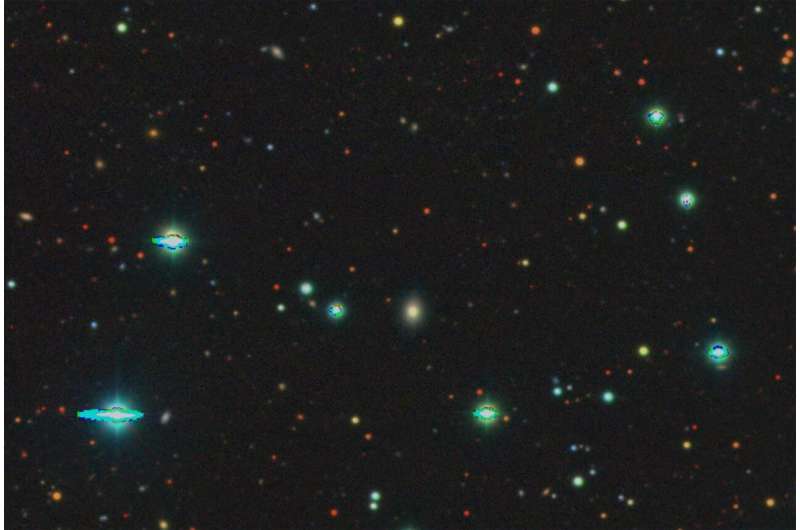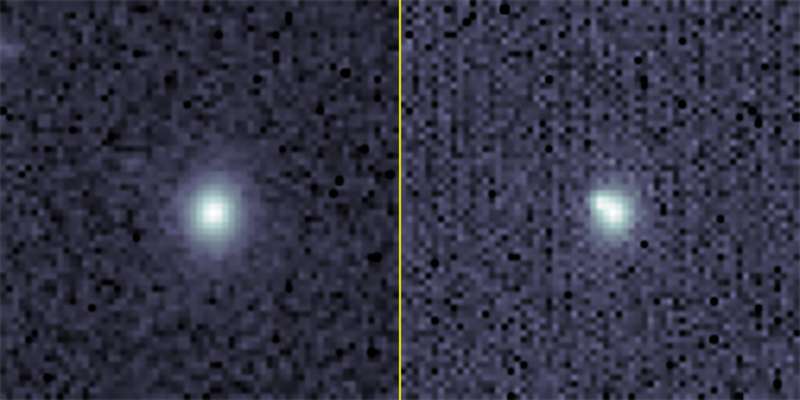First supernova detected, confirmed, classified and shared by AI

A fully automated process, including a brand-new artificial intelligence (AI) tool, has successfully detected, identified and classified its first supernova.
Developed by an international collaboration led by Northwestern University, the new system automates the entire search for new supernovae across the night sky—effectively removing humans from the process. Not only does this rapidly accelerate the process of analyzing and classifying new supernova candidates, it also bypasses human error.
The team alerted the astronomical community to the launch and success of the new tool, called the Bright Transient Survey Bot (BTSbot), this week. In the past six years, humans have spent an estimated total of 2,200 hours visually inspecting and classifying supernova candidates. With the new tool now officially online, researchers can redirect this precious time toward other responsibilities in order to accelerate the pace of discovery.
"For the first time ever, a series of robots and AI algorithms has observed, then identified, then communicated with another telescope to finally confirm the discovery of a supernova," said Northwestern's Adam Miller, who led the work. "This represents an important step forward as further refinement of models will allow the robots to isolate specific subtypes of stellar explosions. Ultimately, removing humans from the loop provides more time for the research team to analyze their observations and develop new hypotheses to explain the origin of the cosmic explosions that we observe."
"We achieved the world's first fully automatic detection, identification and classification of a supernova," added Northwestern's Nabeel Rehemtulla, who co-led the technology development with Miller. "This significantly streamlines large studies of supernovae, helping us better understand the life cycles of stars and the origin of elements supernovae create, like carbon, iron and gold."
Miller is an assistant professor of physics and astronomy at Northwestern's Weinberg College of Arts and Sciences and a member of the Center for Interdisciplinary Exploration and Research in Astrophysics (CIERA). Rehemtulla is an astronomy graduate student in Miller's research group.
Cutting out the middleman
To detect and analyze supernovae, humans currently work hand in hand with robotic systems. First, robotic telescopes repeatedly image the same sections of the night sky, searching for new sources that were not present in previous images. Then, when these telescopes detect something new, humans take over.
"Automated software presents a list of candidate explosions to humans, who spend time verifying the candidates and executing spectroscopic observations," Miller said. "We can only definitively know that a candidate is truly a supernova by collecting its spectrum—the source's dispersed light, which reveals elements present in the explosion. There are existing robotic telescopes that can collect spectra, but this is also often done by humans operating telescopes with spectrographs."

The researchers developed the BTSbot to cut out this human middleman. To develop the AI tool, Rehemtulla trained a machine-learning algorithm with more than 1.4 million historical images from nearly 16,000 sources, including confirmed supernovae, temporarily flaring stars, periodically variable stars and flaring galaxies.
"The Zwicky Transient Facility (ZTF) has been operating for the past six years, and, during that time, I and others have spent more than 2,000 hours visually inspecting candidates and determining which to observe with spectroscopy," said Christoffer Fremling, an astronomer at the California Institute of Technology (Caltech) who developed another AI tool called SNIascore and contributed to the development of BTSbot. "Adding BTSbot to our workflow will eliminate the need for us to spend time inspecting these candidates."
Early success, and a wave of relief
To test the BTSbot, the researchers looked to a newly discovered supernova candidate dubbed SN2023tyk. The ZTF, a robotic observatory that images the night sky in a search for supernovae, first detected the source on Oct. 3. Sifting through ZTF's data in real time, BTSbot found SN2023tyk on Oct. 5.
From there, BTSbot automatically requested the potential supernova's spectrum from Palomar Observatory, where another robotic telescope (SED Machine) performed in-depth observations to obtain the source's spectrum. The SED Machine then sent this spectrum to Caltech's SNIascore to determine the supernova's type: Either a thermonuclear explosion of a white dwarf or the collapse of a massive star's core.
After determining that the candidate was a Type Ia supernova (a stellar explosion in which a white dwarf in a binary star system fully explodes), the automated system publicly shared the discovery with the astronomical community on Oct. 7.
In the first days of running BTSbot, Rehemtulla felt a mix of nerves and excitement.
"The simulated performance was excellent, but you never really know how that translates to the real-world until you actually try it," he said. "Once the observations from SEDM and the automated classification came in from SNIascore, we felt a huge wave of relief. The beauty of it is that, once everything is turned on and working properly, we don't actually do anything. We go to sleep at night, and, in the morning, we see that BTSbot, and these other AIs unwaveringly do their jobs."
Led by Northwestern, the collaboration included astronomers from Caltech, University of Minnesota, Liverpool John Moores University in England and Stockholm University in Sweden.
Provided by Northwestern University
No comments:
Post a Comment